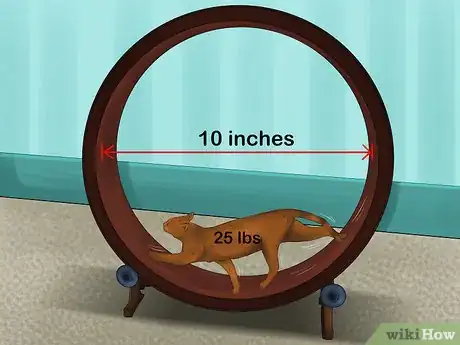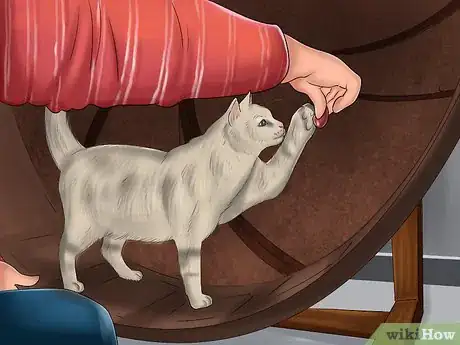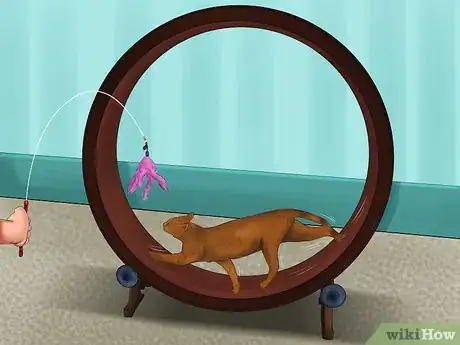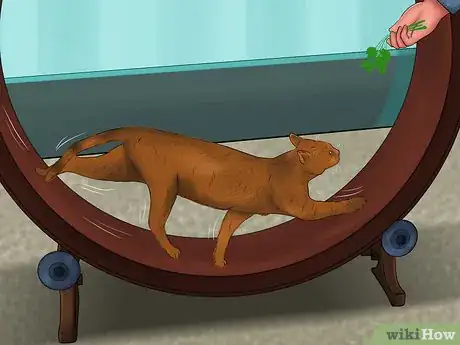This article was co-authored by Ryan Corrigan, LVT, VTS-EVN. Ryan Corrigan is a Licensed Veterinary Technician in California. She received her Bachelor of Science in Veterinary Technology from Purdue University in 2010. She is also a Member of the Academy of Equine Veterinary Nursing Technicians since 2011.
There are 9 references cited in this article, which can be found at the bottom of the page.
This article has been viewed 21,345 times.
Exercise wheels are becoming a popular way to keep cats active. Since they typically cost hundreds of dollars, shop around before making a purchase. Look for sales at nearby pet stores and see if it’s cheaper to purchase a wheel directly from a manufacturer. You can also search for gently used products. Make sure any product you purchase has a return policy, since some cats will refuse to use an exercise wheel. Use either treats or toys to entice your cat to use the wheel. With a little patience, you can teach it to love its new activity.
Steps
Choosing an Exercise Wheel
-
1Shop around for sales and deals. Cat wheels can be a great way to prevent feline obesity and boredom. However, they generally cost between three and nine hundred dollars (US).[1] If you see a product in a pet store, look online to see if it’s cheaper to order it directly from the manufacturer.
- Keep an eye out for sales at your local pet stores.
- You can also look online for gently used products.
-
2Look for a crowdfunded product. The cat wheel market is a relatively new phenomenon. You might come across an online campaign to crowdsource a new product. Check a campaign’s list of perks and see if they offer a cat wheel as a reward when you pledge a set amount of money.[2]
- Try visiting the homepages of crowdfunding sites like Kickstarter and Indiegogo. Enter "cat exercise wheel" into the search bars on their pages to see if there are any active campaigns. You can also run a Google search for "cat exercise wheel crowdfunding."
- You might be able to save hundreds of dollars on a cat wheel by donating to a crowdfunding campaign. Just keep in mind that some campaigns, like those hosted on Kickstarter, only offer the reward if the funding goal is met.
- You’ll also have to be patient, as it’ll take much longer to receive the wheel from a crowdfunding campaign than to purchase one from a pet store or manufacturer.
Advertisement -
3Choose a product with a warranty. Some cats simply won’t tolerate running on a wheel. Since they usually cost hundreds of dollars, check a product’s warranty or store’s return policy before you make a purchase.
- Many products come with a 90-day return policy, but you might have to pay shipping and a restocking fee.
- Since they’re prone to wear and tear, you should also make sure the wheel’s bearings are covered by warranty for at least a year.
-
4Get a wheel large enough for your cat. Most cat exercise wheels have a weight limit of 25 pounds (about 12 kilograms).[3] Most wheels have a four-foot diameter and 10 inch (25.4 cm) wheel width, but some manufacturers offer wheels with diameters of either three or four feet (about one meter or a meter and a quarter).
- Before you start shopping, measure your cat's weight, length, and height. Compare this to the size of each wheel to find a wheel that is the perfect fit for your cat.
- A four-foot diameter is designed to fit even the longest cats. However, you'll want to make sure your cat is within the weight limit. You can also contact your cat's vet if you have any concerns about your cat's size and safety when using an exercise wheel.
-
5Use wood slates to stabilize the wheel if you have plush carpets. Cat exercise wheels are most stable on hard floors and thin carpeting. If you have thick or soft carpeting throughout your home, you could place a wood slate beneath the wheel. This will add a uniform, stable surface for the wheel.[4]
-
6Assemble your cat exercise wheel. You'll likely have to assemble the base of your new exercise wheel. Typically, this involves attaching two-footed parts with bearing wheels to both ends of a supporting rod. The footed ends sit on the floor, and the wheel sits on top of the bearing wheels.[5]
- Your product will come with instructions if the base requires home assembly.
Enticing Your Cat to Use an Exercise Wheel
-
1Train your cat to get on the wheel using treats. Hold a treat on the wheel to get your treat-driven cat to climb onto it. If necessary, gently place the cat onto the wheel. Give your cat a small treat as soon as it’s on the wheel, then repeat the sequence for 15 to 20 minutes.[6]
- Once it's on the wheel, gradually hold a treat further away from your cat to teach it to move forward. Start to hold a treat at a quarter of the wheel’s height, then work your way up to a third of its height. Slowly increase the height at which you hold the treat until you can get past half of the wheel’s height.[7]
- Give the cat a treat if it stays on the wheel or if it starts walking on its own. This will encourage your cat to use the wheel without you.
- Break up treats into tiny pieces so you can reward your cat without overfeeding it.
- Consider wearing a glove to avoid getting scratched when your cat goes after the treat.
-
2Use a feather wand to get your cat to climb onto the wheel. If your cat ignores treats but responds to toys, a wand toy will give you the most control when you train it. Start by shaking the wand on the ground around the wheel to get your cat’s attention. Then move the toy onto the wheel to get your cat to climb onto it.[8]
- Move the toy on and off of the wheel for 15 to 20 minutes to get your cat comfortable enough to get onto it.
- Once it's comfortable with getting on the wheel, shake the toy forward so the cat has to spin the wheel to pounce on the toy.[9]
-
3Try using a laser pointer if you have trouble with a wand. If you have difficulty holding your cat’s attention with the feather wand, try using a laser pointer. You can either use it in place of or in combination with the wand to keep your cat engaged.
- Experiment with different toys to identify the ones that most effectively lure your cat.
- Like wand toys, a laser pointer will allow you to direct your cat where you want it to go.
-
4Use catnip if it energizes your cat. Catnip stimulates some cats and makes others mellow. If it makes your cat hyperactive, sprinkle some dried catnip on the wheel to encourage your cat to run on it. You can also hold a catnip-laced toy just out of your cat’s reach so it runs on the wheel and tries to get the toy.[10]
References
- ↑ http://www.petguide.com/blog/cat/how-a-cat-exercise-wheel-can-fight-obesity/
- ↑ https://www.cnet.com/news/one-fast-cat-a-hamster-wheel-for-kitty/
- ↑ http://onefastcat.com/index.php/faq
- ↑ http://onefastcat.com/index.php/faq
- ↑ https://www.youtube.com/watch?v=UhMGBzg51S4&feature=youtu.be&t=50
- ↑ https://www.youtube.com/watch?v=02FL092Qk_k&feature=youtu.be&t=134
- ↑ https://www.youtube.com/watch?v=02FL092Qk_k&feature=youtu.be&t=171
- ↑ https://www.youtube.com/watch?v=02FL092Qk_k&feature=youtu.be&t=403
- ↑ https://www.youtube.com/watch?v=02FL092Qk_k&feature=youtu.be&t=507































































